The Morgan Library is a fascinating museum with a unique collection of valuable manuscripts, books and drawings assembled by John Pierpont Morgan, one of the wealthiest and most powerful men in American history.
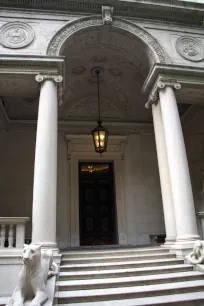
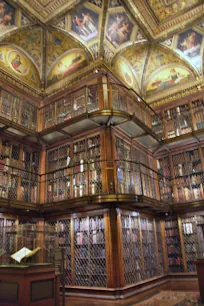
Visitors also get the opportunity to see Morgan’s opulent historic library and study, built in 1903-1906 in the style of a Roman villa.
History
In the second half of the nineteenth century, John Pierpont Morgan, an industrialist and Wall Street Financier, purchased three brownstone mansions in the upscale Murray Hill district. Morgan and his wife lived in the southernmost building at 36th Street and Madison Avenue. The northernmost building, at 37th Street, he gave to his son, while the middle building was torn down to make way for a garden.
In 1900 J.P. Morgan’s collection of books and manuscripts had become so large that he decided to expand his house with a private library. He asked architect Whitney Warren of Warren and Wetmore to draw up plans for an annex with a library and study. In 1902 Morgan changed his mind and handed the project to Charles McKim of the accomplished architectural firm of McKim, Mead & White. McKim, in close cooperation with Morgan, designed an opulent villa in classical Roman style.
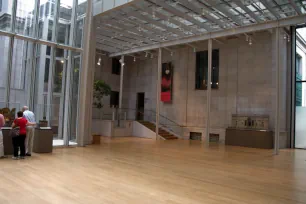
After J.P. Morgan’s death in 1913 his son, Jack, demolished his father’s nineteenth century residence so that he could expand the library. In 1924, he opened the library to the public and founded the Morgan Library Institution in memory of his father. In 1988 Jack Morgan’s own residence was added to the library complex, and finally in 2006 the Italian architect Renzo Piano expanded the museum with modern pavilions. He also created a glass atrium at the site of the former garden, which ties together the different museum buildings.
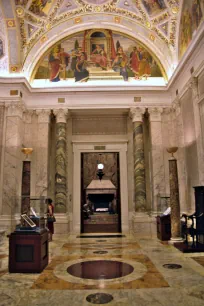
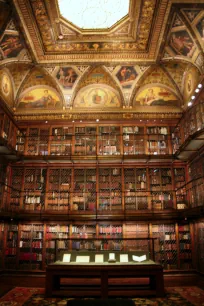
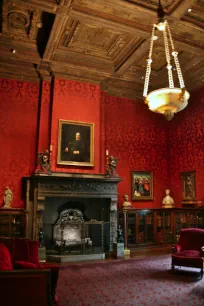
The Library and Study
The Morgan Library is considered one of the masterpieces of Charles McKim. J.P. Morgan set no budget limit, so all the materials were of the highest quality, some of which were transported all the way from Europe. The architect convinced Morgan to build his library without the use of any mortar. McKim had studied the Erechtheion at the Acropolis – which is still standing after 2500 years – and decided to use this ancient technique, despite the extra cost involved. All marble blocks had to be precisely measured and placed so that not even a knife could be inserted between the stones.
The original main entrance at 37th Street brought visitors into a central rotunda, reminiscent of Roman palaces. The Rotunda is embellished with marble columns and pilasters and features a colorful marble floor with a Roman style pattern. The domed ceiling is decorated with gilded patterns, reliefs and paintings with classical scenes created by Harry Siddons Mowbray.
The rotunda is connected to three rooms: the library to the east, the study to the west and the librarian’s office to the north. The library room holds rows of historic books, three stories high. The room has a magnificent painted ceiling with a beautiful skylight. A sixteenth century tapestry by Pieter Coecke van Aelst, entitled ‘The Triumph of Avarice’, hangs above a beautifully sculpted fireplace. The study room, where Morgan kept some of his favorite artwork, is lined in red silken damask and decorated with several paintings, including portraits of J.P. Morgan and his son Jack. The study has a wooden coffered ceiling in the style of a Roman Renaissance palazzo.
The original entrance on 36th Street is also classical in style, with an archway supported by Ionic columns. The entrance is flanked by two lion statues, created by Edward Clark Potter, an American sculptor who would later create the famous lion statues in front of the New York Public Library.
The Museum
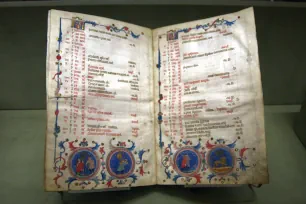
John Pierpont Morgan started collecting around 1890 to expand his library. As a result, the museum’s collection contains many books, manuscripts and other literary items such as private letters. Over time Morgan’s interests began to broaden, and he acquired valuable paintings, statues and other objects. He donated many works of art to the Metropolitan Museum, but his most cherished artworks, books and manuscripts he kept for himself. After his death in 1913 his son continued to expand the collection and even today the museum still occasionally acquires valuable documents such as a document signed by president Abraham Lincoln, purchased in 1992.
The museum displays some of the most valuable and interesting items in the collection, including drawings from Rembrandt, Dürer and Rubens, music manuscripts created by Beethoven, Bach and Mozart, and manuscripts and letters from writers including Mark Twain and Charles Dickens. There are also numerous historic manuscripts and printed books on display, most notably a Gutenberg Bible (the museum owns three!) and manuscripts from the Middle Ages, including a tenth century copy of the Beatus.

